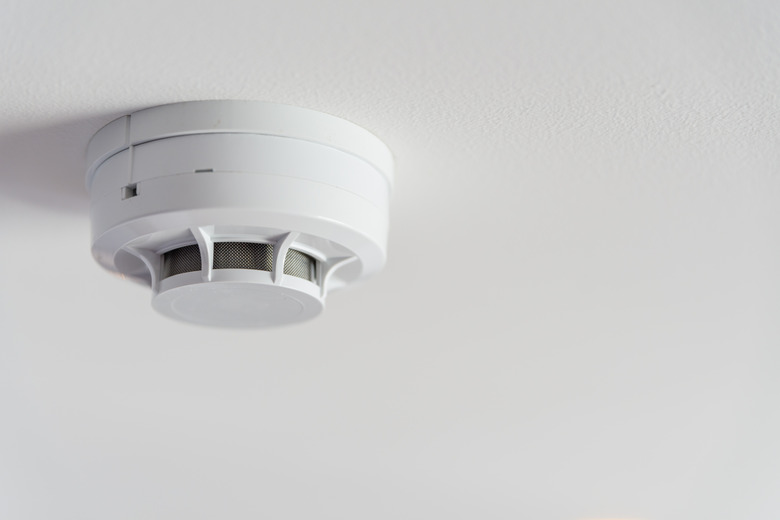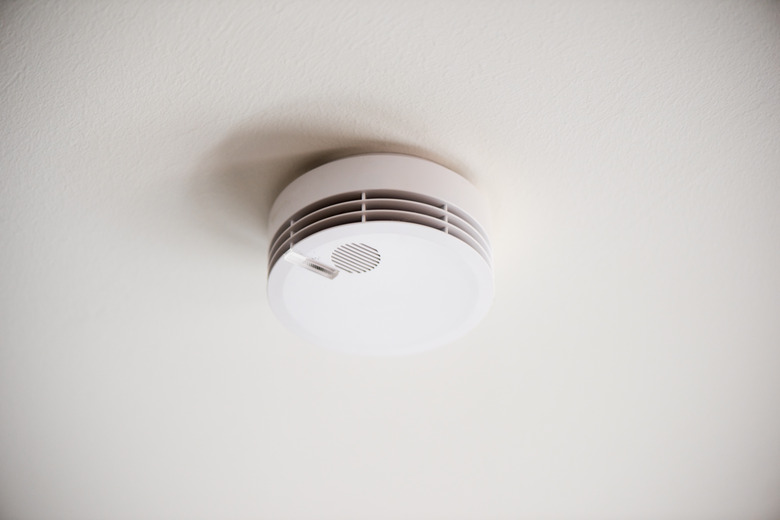Smoke Alarms And Carbon Monoxide Detectors: What You Need And Where They Should Go In Your Home
Smoke alarms and carbon monoxide (CO) detectors save lives, which is why the National Fire Protection Association (NFPA) wants them in every home in America. While its guidance carries a lot of weight, the NFPA doesn't make laws, and implementation by state legislative bodies and fire marshals varies, so homeowners have to be aware of their state laws. The website maintained by Universal Security Instruments is one place you can go to find the most current requirements for smoke detectors and carbon monoxide detectors in each state.
As you would expect, highly regulated California follows NFPA guidance as closely as any state, and the building code requires smoke alarms and carbon monoxide detectors in every dwelling unit, not just those that have been newly built or remodeled. Kansas, on the other hand, generally requires smoke alarms in all residential settings, but its laws make no mention of carbon monoxide detectors. Kansas is an outlier, however, as the vast majority of states have requirements for both smoke alarms and carbon monoxide detectors. Iowa goes so far as to require dual-sensor smoke alarms, which are capable of detecting a broader range of fire events.
Given that it's the NFPA's job to prevent fires, its guidance is the gold standard in terms of selection and placement of smoke alarms and CO detectors, and if you conform to it, you're sure to be in compliance with your state's laws. The fact that state legislators haven't gotten around to writing laws that require them is no reason not to install CO detectors and smoke alarms in every bedroom, given that fire safety is so important. The alarms will hopefully never go off, but if they do, they could make a life or death difference.
Different Types of Smoke Detectors
Smoke detectors employ one of two technologies to detect fires: the photoelectric effect and ionization, and dual-sensor alarms use both. The sensor in a photoelectric smoke alarm consists of a semiconducting plate and a beam of light that is shining at an angle with respect to the plate. When smoke enters the sensing chamber and deflects the light toward the plate, a small voltage is generated that sounds the alarm. In an ionization smoke alarm, a steady beam of radioactive particles ionizes the air between a pair of plates, generating a current. When smoke enters the chamber and disrupts the current, the alarm sounds.
Photoelectric sensors are better at detecting smoke from smoldering fires, while ionization detectors are better at detecting flaming fires. Most smoke detectors on the market are the photoelectric type, but both the NFPA and the U.S. Fire Administration recommend having both types in your house since you never know what type of fire might break out. Both organizations recommend dual-sensor alarms employing both types of sensors, and some states (such as Iowa) have laws requiring them.
Choosing a dual-sensor smoke alarm saves you from having to choose one type of sensor and losing the functionality of the other or having to install twice the number of smoke detectors you really need, but because of the enhanced sensitivity, false alarms are more likely with dual sensors. To avoid an ear-piecing alarm when you're cooking or when you come out of the shower (smoke alarms often mistake steam for smoke), choose a model that has been engineered to reduce false alarms, such as the First Alert SA320CN.
Where Should You Put Smoke Alarms?
Although placement requirements may vary from state to state, it's best to follow NFPA guidance. That way, you won't have to make any changes if and when your state updates its requirements to bring them in line with those of the NFPA, as many have already done.
According to the NFPA, you should have at least one smoke alarm on every level of the home, including the basement and attic, and there should be one inside and outside every bedroom or separate sleeping area. When more than one bedroom door opens into a common hallway, a single alarm in the hallway can usually serve all the bedrooms. On levels without bedrooms, there should be a smoke alarm in the largest room, at the bottom of the stairway leading up to the next level or, better yet, in both places. To avoid false alarms, smoke alarms should be at least 10 feet from cooking appliances.
Some additional guidelines for installing smoke alarms include:
- Mount them on the ceiling or high on the wall, keeping in mind that smoke rises. They should be no more than 12 inches from the ceiling.
- When installing in a room with a peaked ceiling, place a smoke alarm within 3 feet of the peak but no closer than 4 inches.
- Don't install smoke alarms near doors, windows, air vents or anywhere there's likely to be a draft that can direct smoke away from them.
Do You Need Carbon Monoxide Detectors?
Forty-four states have laws requiring CO alarms in dwelling units, but not all states specify where they should be placed. Carbon monoxide is a byproduct of fossil fuel combustion, so any home that uses gas for heating or cooking should have them regardless of state requirements. They are also required in any home with an attached garage since cars also exhaust CO gas. Carbon monoxide is invisible, odorless and deadly, so when a CO alarm sounds, it should be taken seriously, and anyone experiencing symptoms of carbon monoxide poisoning should get medical attention.
The NFPA recommends putting one carbon monoxide detector in a central location in each bedroom. CO gas is slightly lighter than air, so detectors should be placed at least 5 feet from the floor on walls or mounted on the ceiling. Some manufacturers may specify the best location on the packaging. Some locations aren't ideal and should be avoided, such as:
- Closer than 10 feet to any fuel-burning appliance
- Near areas of high humidity, such as the bathroom or kitchen
- In direct sunlight
- In areas of high air circulation, including near doors, windows or air vents
Combination smoke alarms combine the functionality of dual-sensor smoke alarms with carbon monoxide detectors to detect flame fire, smoldering fires and carbon monoxide. These are convenient, but Consumer Reports says that few of them are effective at monitoring all three and advises that you install smoke detectors and carbon monoxide detectors separately.
Hardwired, Battery-Powered and Interconnected Detectors
Smoke and carbon monoxide detectors need a power source, and the most convenient is battery power. In 2014, California enacted legislation that requires all battery-powered smoke alarms to have sealed batteries that last 10 years, with the date of manufacture displayed on the devices. This is also required for carbon monoxide detectors as of 2015, and although this isn't a nationwide requirement, it has become a standard adopted by most manufacturers. Most hardwired smoke alarms also have sealed 10-year batteries.
Hardwired smoke alarms are wired into an electrical circuit connected to the home's service panel and are more reliable than battery-powered ones, but since they usually must be installed by an electrician, many homeowners opt for battery-powered ones, which can simply be mounted as is. Both types have batteries, but the batteries in hardwired alarms are intended only for backup in the event of a power outage. When the battery backup gets weak, the units will chirp at one-minute intervals until new batteries are installed. Sealed units have to be replaced.
One of the reasons for hardwiring smoke alarms is to make an interconnected system so that if a fire is detected in one location, all the alarms will sound. Interconnected systems are safer, and the NFPA recommends them, reporting that they increase the likelihood of people being alerted to a home fire. Wi-Fi-enabled smoke alarms make it easy to install an interconnected alarm system without running new wires because they interconnect wirelessly. You can even interconnect conventional units wirelessly by replacing the batteries with Wi-Fi-enabled ones.
Maintaining Smoke and Carbon Monoxide Detectors
Even though it's a jarring experience, it's important to test smoke and carbon monoxide detectors once a month by pressing the test button and ensuring the alarm sounds. Any device that doesn't respond with an ear-piercing alarm needs to be replaced. Also, as almost every homeowner and renter knows, smoke and CO alarms alert you with a chirping sound when the battery is low and needs to be replaced. If you have an older unit, follow the manufacturer's instructions for replacing the battery, but if you have a sealed smoke alarm, you need to replace the whole unit.
Modern smoke alarms have batteries that are designed to last 10 years, and when that period has expired, the batteries or the entire unit has to be replaced even if you don't hear the chirping sound. To help you keep track, you should write down the manufacture dates of all the units in the house on a piece of paper and keep it in an easily accessible place for reference. If you have Wi-Fi-enabled alarms or batteries, you can monitor them using an app on your laptop or mobile device. Some Wi-Fi devices can connect with a home assistant, such as Amazon Alexa, which will give you audible reminders when it's time to replace them.
Dealing With False Alarms
Nuisance alarms can be a problem with smoke detectors, which is why states like California require them to be equipped with hush buttons. When a smoke alarm sounds, the first thing to do, of course, is make sure that it isn't actually signaling a fire, and only after you've determined that no danger exists should you silence the alarm by pushing the button. If you have a Wi-Fi-enabled model, you should be able to hush it remotely using an app on your mobile device or laptop.
When a smoke detector repeatedly gives false alarms, the most common cause is poor placement. It's often too close to the bathroom or kitchen and is mistaking steam or humidity in the air for smoke. It's also possible that the sensor is dirty, and you can often fix this particular problem by blowing canned compressed air through the grille to clear debris. That will also blow away any insects that have gotten inside and are crawling around the sensor. You can also reduce the sensitivity of a smoke detector that gives frequent false alarms by following the manufacturer's instructions but do that only if needed because you're also reducing the protection it gives you.
Carbon monoxide detectors aren't as prone to false alarms as smoke detectors, and if one goes off, you should check the reading on its meter. A reading in excess of 30 to 40 parts per million over an eight-hour period will set off the alarm, but it isn't an emergency. If the reading exceeds 200 parts per million, you're in danger, so turn off all the gas appliances, including the furnace, get out of the house immediately and don't go back in until levels drop to a safe range. Seek medical attention if you're experiencing drowsiness, dizziness or nausea.
References
- Universal Security Instruments: Smoke & CO Alarm Legislation Laws by State
- U.S. Fire Administration: USFA Position on Home Smoke Alarms
- National Fire Protection Association: Installing and Maintaining Smoke Alarms
- Consumer Reports: Smoke & Carbon Monoxide Detector Buying Guide
- First Alert: Where to Place Smoke Alarms, CO Detectors and Fire Extinguishers in Your Home
- U.S. Environmental Protection Agency: Where Sould I Place a Carbon Monoxide Detector?
- Vivint: The 7 Most Common Reasons for Smoke Detector False Alarms

